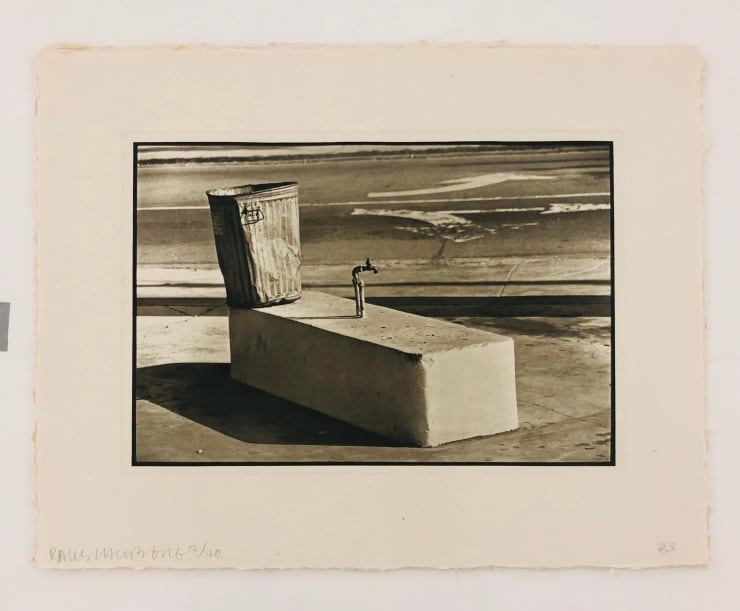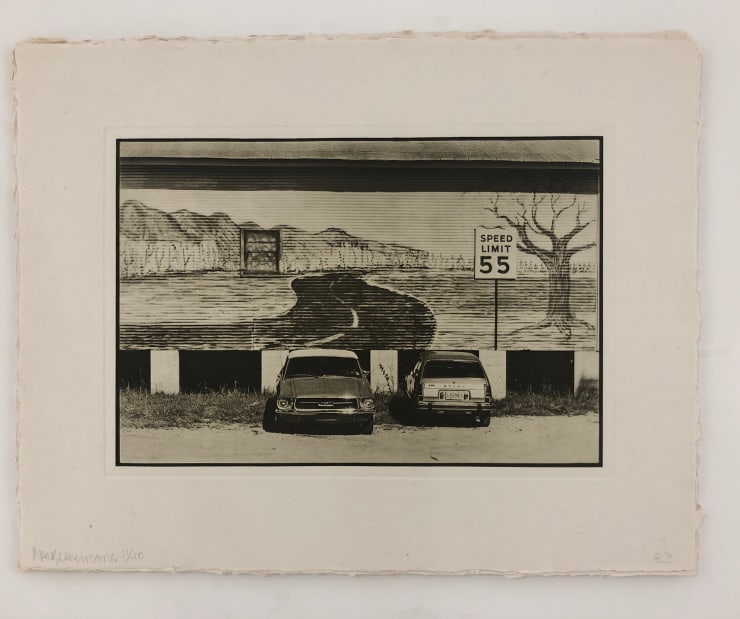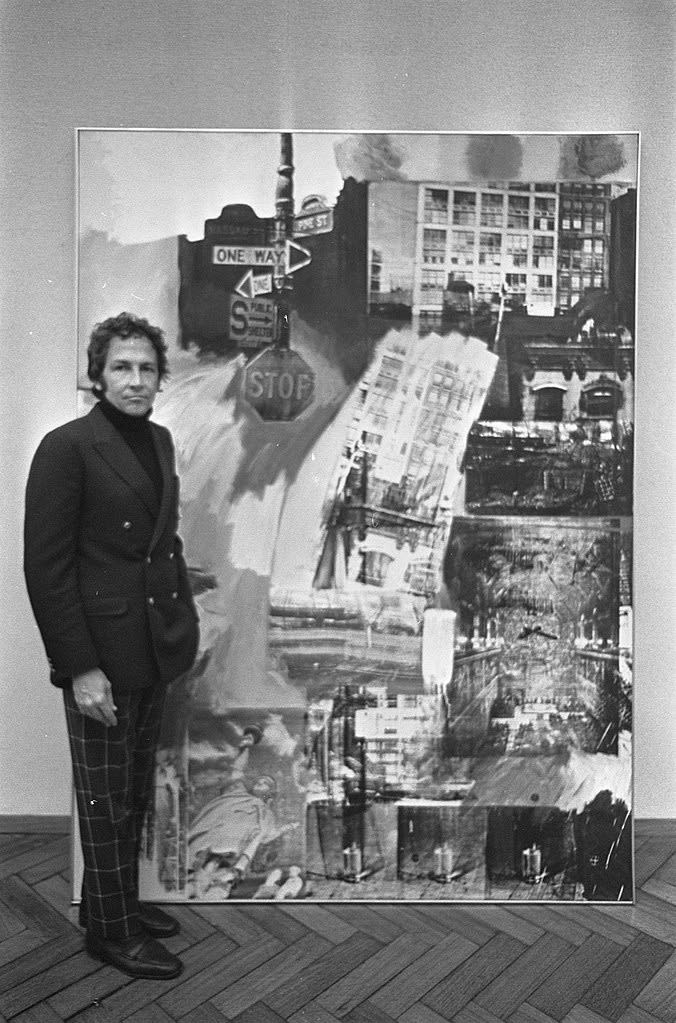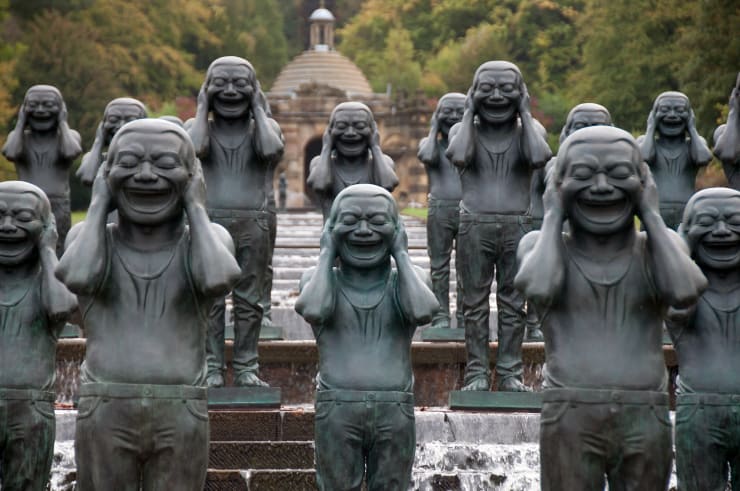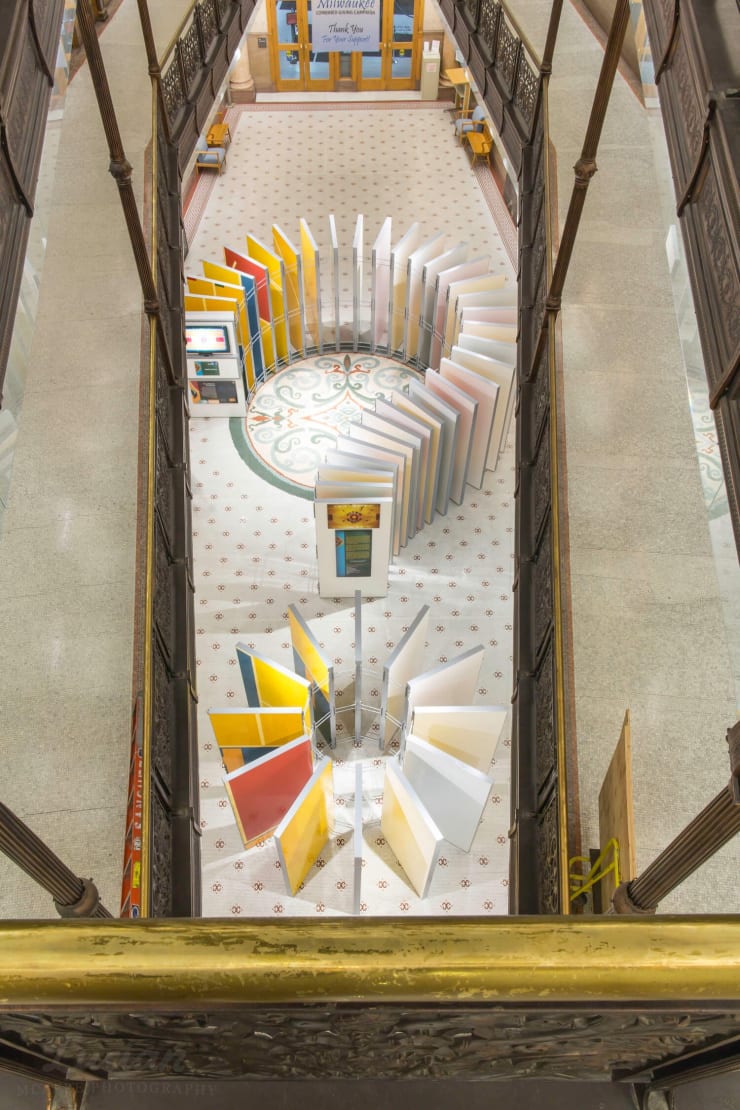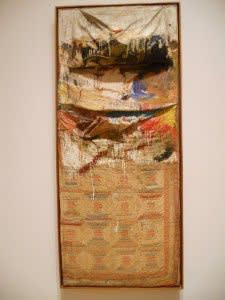Robert Rauschenberg
-
 Robert RauschenbergResidence, 1997Screenprint On Lanquarelle WC 640g70 x 32 ins 177.8 x 81.28 cm
Robert RauschenbergResidence, 1997Screenprint On Lanquarelle WC 640g70 x 32 ins 177.8 x 81.28 cm -
 Robert RauschenbergSource, 1996Screenprint47 5/8 x 70 2/8 ins 121.28 x 178.44 cm
Robert RauschenbergSource, 1996Screenprint47 5/8 x 70 2/8 ins 121.28 x 178.44 cm -
 Robert RauschenbergAmerican Mix, 1983Photogravure Chine Colle on Handmade paper20 x 26 ins 50.8 x 66.04 cmSigned, dated and numberd in pencil
Robert RauschenbergAmerican Mix, 1983Photogravure Chine Colle on Handmade paper20 x 26 ins 50.8 x 66.04 cmSigned, dated and numberd in pencil -
 Robert RauschenbergAmerican Mix, 1983Photogravure Chine Colle on Handmade paper20 x 26 ins 50.8 x 66.04 cmSigned, dated and numberd in pencil
Robert RauschenbergAmerican Mix, 1983Photogravure Chine Colle on Handmade paper20 x 26 ins 50.8 x 66.04 cmSigned, dated and numberd in pencil -
 Robert RauschenbergAmerican Mix, 1983Photogravure Chine Colle on Handmade paper20 x 26 ins 50.8 x 66.04 cmSigned, dated and numberd in pencil
Robert RauschenbergAmerican Mix, 1983Photogravure Chine Colle on Handmade paper20 x 26 ins 50.8 x 66.04 cmSigned, dated and numberd in pencil -
 Robert RauschenbergAmerican Mix, 1983Photogravure Chine Colle on Handmade paper26 x 20 ins 66.04 x 50.8 cmSigned, dated and numberd in pencil
Robert RauschenbergAmerican Mix, 1983Photogravure Chine Colle on Handmade paper26 x 20 ins 66.04 x 50.8 cmSigned, dated and numberd in pencil -
 Robert RauschenbergAmerican Mix, 1983Photogravure Chine Colle on Handmade paper20 x 26 ins 50.8 x 66.04 cmSigned, dated and numberd in pencil
Robert RauschenbergAmerican Mix, 1983Photogravure Chine Colle on Handmade paper20 x 26 ins 50.8 x 66.04 cmSigned, dated and numberd in pencil -
 Robert RauschenbergAmerican Mix, 1983Photogravure Chine Colle on Handmade paper20 x 26 ins 50.8 x 66.04 cmSigned, dated and numberd in pencil
Robert RauschenbergAmerican Mix, 1983Photogravure Chine Colle on Handmade paper20 x 26 ins 50.8 x 66.04 cmSigned, dated and numberd in pencil -
 Robert RauschenbergAmerican Mix 16, 1983Photogravure Chine Colle on Handmade paper20 x 26 ins 50.8 x 66.04 cmSigned numbered and dated in pencil
Robert RauschenbergAmerican Mix 16, 1983Photogravure Chine Colle on Handmade paper20 x 26 ins 50.8 x 66.04 cmSigned numbered and dated in pencil -
 Robert RauschenbergAmerican Mix 16, 1983Photogravure Chine Colle on Handmade paper20 x 26 ins 50.8 x 66.04 cmSigned, dated and numberd in pencil
Robert RauschenbergAmerican Mix 16, 1983Photogravure Chine Colle on Handmade paper20 x 26 ins 50.8 x 66.04 cmSigned, dated and numberd in pencil -
 Robert RauschenbergAmerican Mix 16, 1983Photogravure Chine Colle on Handmade paper20 x 26 ins 50.8 x 66.04 cmSigned, dated and numberd in pencil
Robert RauschenbergAmerican Mix 16, 1983Photogravure Chine Colle on Handmade paper20 x 26 ins 50.8 x 66.04 cmSigned, dated and numberd in pencil -
 Robert RauschenbergAmerican Mix 16, 1983Photogravure Chine Colle on Handmade paper20 x 26 ins 50.8 x 66.04 cmSigned, dated and numberd in pencil
Robert RauschenbergAmerican Mix 16, 1983Photogravure Chine Colle on Handmade paper20 x 26 ins 50.8 x 66.04 cmSigned, dated and numberd in pencil -
 Robert RauschenbergAmerican Mix 16, 1983Photogravure Chine Colle on Handmade paper26 x 20 ins 66.04 x 50.8 cmSigned, dated and numberd in pencil
Robert RauschenbergAmerican Mix 16, 1983Photogravure Chine Colle on Handmade paper26 x 20 ins 66.04 x 50.8 cmSigned, dated and numberd in pencil -
 Robert RauschenbergAmerican Mix 16, 1983Photogravure Chine Colle on Handmade paper20 x 26 ins 50.8 x 66.04 cmSigned, dated and numberd in pencil
Robert RauschenbergAmerican Mix 16, 1983Photogravure Chine Colle on Handmade paper20 x 26 ins 50.8 x 66.04 cmSigned, dated and numberd in pencil -
 Robert RauschenbergAmerican Mix, 1982Photogravure Chine Colle on Handmade paper20 x 26 ins 50.8 x 66.04 cmSigned, dated and numberd in pencil
Robert RauschenbergAmerican Mix, 1982Photogravure Chine Colle on Handmade paper20 x 26 ins 50.8 x 66.04 cmSigned, dated and numberd in pencil -
 Robert RauschenbergHowl from Seven Characters, 1982Paper & fabric collage with mirror and embossing on Chinese Xuan paper42 1/2 x 30 1/2 ins 107.95 x 77.47 cm
Robert RauschenbergHowl from Seven Characters, 1982Paper & fabric collage with mirror and embossing on Chinese Xuan paper42 1/2 x 30 1/2 ins 107.95 x 77.47 cm -
 Robert RauschenbergArcanum VI, 1981Screenprint With Hand Coloring And Collage22 5/8 x 15 6/8 ins 57.78 x 40.01 cm
Robert RauschenbergArcanum VI, 1981Screenprint With Hand Coloring And Collage22 5/8 x 15 6/8 ins 57.78 x 40.01 cm
Robert Rauschenberg was an American artist best known for his bold and inventive contributions to the Abstract Expressionist and Pop Art movements. Born in Port Arthur, Texas in 1925, Rauschenberg first recognized the capacity of his artistic talents while serving the U.S. Military in 1947.
Following his time in the service, he pursued art studies at the Kansas City Art Institute prior to attending moving to Paris to attend the Academie Julian. After less than one year in Paris, Rauschenberg found himself dissatisfied with the European Abstract Expressionist art scene and returned to the United States, opting to continue his studies at Black Mountain College in North Carolina, learning from Bauhaus founder Joseph Albers. At that time, the school had become a hotbed of avante garde collaboration and featured a number of talented artists who began drawing national attention, including dancer Merce Cunningham and musician John Cage.
In time, Robert Rauschenberg sought new inspiration and headed to New York City, studying at the Art Students League of New York between 1949 and 1952. It was here that he met fellow artists Cy Twombly and Knox Martin. In the burgeoning New York Abstract Expressionist movement, Robert Rauschenberg would push the limits of form and expression, influencing an upcoming generation of Pop Artists in the process, including Jasper Johns and Andy Warhol
Monochrome Paintings
In the early 1950s, Rauschenberg’s Abstract Expressionist works included series of monochromatic paintings, singular color works, considered alternatively confounding and inspiring. Within the 1951 White Paintings series, the artist proposed that his seemingly static white paintings were actually dynamically altered by ambient components − shadows, natural and artificial lighting, dust particles and angles of view – in fact changing the work itself. Robert Rauschenberg’s black paintings were similar in terms of ambient sensitivities, but these works also included a new dimension of texture provided by embedded pieces of newspaper that were added to canvases. The newspaper would sometimes be completely covered in paint, barely distinguishable, and other times left partially revealed, print and all.
Following the Black Paintings, Robert Rauschenberg’s Red Paintings stepped the artist into a new realm of works called “Combines,” a style of works for which Rauschenberg would become most famous. Rauschenberg’s Red Paintings (1953-1954) introduced assorted cuts of wood, nails and other materials to the monochrome layers of red paint. Additionally, Red Paintings included enhanced textures created by paint application processes – such as drips, spatters, washes and bold horizontal strokes.
“Combines”
As the name indicates, “combines” is the term applied to the works of Robert Rauschenberg that put together a combination of objects, causing the viewer to ponder the meaning of the often surprising juxtapositions. Rauschenberg would actively collect rubbish found on the streets of Manhattan, to include these items within such works. The unpredictability of what could be found energized the artist’s philosophies of art as an unpredictable exploration.
Monogram (1959) is arguably the creation for which Robert Rauschenberg is most famous. The work, considered a “combine,” juxtaposes seemingly unrelated objects – including a painted taxidermy goat, a car tire and a tennis ball. Rauschenberg’s statement could be inferred loud and clear, “these objects are related because I’ve made it so.”
Robert Rauschenberg noticed that even in juxtaposing seemingly meaningless elements, he could nonetheless tell a story and elicit emotions, even common emotions, based upon the collective meaning or significance that particular objects represent in popular culture. This philosophical approach played an important role in laying the foundation of the Pop Art movement. For Pop Artists such Andy Warhol and Roy Lichtenstein, it was merely a short jump from the inclusion of popular objects in the works of Rauschenberg to placing sole focus on Pop icons and manipulating or morphing identifying characteristics.
Among Robert Rauschenberg’s significant “combination” contributions includes collaborations forged between visual art, performance art and even engineering. Throughout his career, Rauschenberg designed sets and costumes for dance, most regularly for the Merce Cunningham Dance Company. In 1977, Rauschenberg collaborated with Merce Cunningham and John Cage, both of whom he befriended as a student at Black Mountain College.
Working with engineer Billy Kluver, Rauschenberg founded a non-profit organization called E.A.T., standing for Experiments in Arts and Technology. In gratitude, NASA invited Rauschenberg to witness to the launch of the Apollo 11 rocket and provided the artist with access to archival documents and images. Rauschenberg created his “Stoned Moon Series” of lithographs as his response to this historic event and unique opportunity. These lithographs would become shining examples of powerful Pop Art printmaking.
Among the many notable commissions for which Robert Rauschenberg won acclaim is a Grammy Award for his design of the Talking Heads album, “Speaking in Tongues.”
In 2008, Robert Rauschenberg died on Captiva Island, FL, where the artist worked exclusively in his later years. The artist’s works continue to be highly sought, many hanging in galleries and exhibits throughout the world.
-

Helen Frankenthaler and Modern and Contemporary Fine Art Print Artists
January 3, 2024One of the pleasures of focusing on fine art prints at VFA, is seeing the looks on people’s faces when they discover the depth, beauty...Read more -

Lucy Sparrow's Deli. En Imamura's New Studio
A New Book About the Artists of Coenties Slip October 10, 2023Lucy Sparrow’s (b.1986) third solo show in New York is on exhibit now. It is as unique, entertaining and fun as all of her previous...Read more -

Carmen Herrera and Ellsworth Kelly Exhibits
March 29, 2023In 2021, the Blanton Museum of Art at the University of Texas in Austin, commissioned Cuban-American artist Carmen Herrera to create a mural for the...Read more -

Robert Rauschenberg's Archive, New Yue Minjun, Kenny Scharf's Cosmic Cavern in London
March 2, 2023Robert Rauschenberg In 1965, before Robert Rauschenberg moved to Captiva Island, he lived in a building on Lafayette Street in Manhattan that had been an...Read more -

Robert Rauschenberg: Seven Character Series
June 14, 2022Robert Rauschenberg 1925-2008 There is no reason not to consider the world as one gigantic painting. – Robert Rauschenberg Robert Rauschenberg believed that art could...Read more -

Honoring the Printmaker
April 5, 2022A current exhibit at the Albuquerque Museum pays tribute to master printers. It is their skills, talents and ability to problem solve that help to...Read more -

Chuck Close: Battle for Artists’ Royalties is Over
August 7, 2018The works of Chuck Close have garnered historically high prices at auction. Close and other artists would like a percentage of the auction price, but,...Read more -

Robert Indiana: In Miami, Selling MECCA
September 7, 2017The works of Robert Indiana , and many other great mid-twentieth century artists, will be on display at the University of Miami's Lowe Art Museum...Read more -

Andy Warhol Art for Sale
August 1, 2016At Vertu, we aim to promote modern art by collecting a broad range of artworks from modern artists creating artworks in various styles. We enjoy...Read more -

Jasper Johns Prints for Sale
March 23, 2016He's painted a flag so you don't have to think of it as a flag but only as a painting' -Jasper Johns Jasper Johns has...Read more -

Robert Rauschenberg Prints: Beijing and Black Mountain
February 24, 2016Robert Rauschenberg’s prints and paintings continue to be a source of joy and inspiration to art enthusiasts around the world. His 1/4 Mile or 2...Read more -

Rauschenberg Replaces Roosevelt in the White House
October 28, 2015In a bold and beautiful move, President Obama and First Lady, Michelle, have updated the look of the White House with contemporary art, including Robert...Read more -

Rauschenberg’s Monogram (Will Never Make it to the Vatican)
August 28, 2015Robert Rauschenberg’s Monogram opened the door for his contemporaries, like Andy Warhol, to do more than place paint on canvas, ink on paper or a chisel to stone. Rauschenberg was a young artist in New York, in 1955, when he saw a stuffed angora goat in the window of a used office furniture store. The store owner was asking $35 for the goat. Rauschenberg only had $15 in his pocket. Rauschenberg took the goat, and promised to return with the rest.Read more -

Robert Rauschenberg Prints at VFA
October 25, 2013Vertu Fine Art is pleased to present a few examples of the impressive Robert Rauschenberg prints for sale at our South Florida art gallery. Rauschenberg’s contributions as an Abstract Expressionist and Pop Artist were powerful and significant in defining moments attributed to both movements.Read more -

Robert Rauschenberg: Highly Contextual
July 29, 2013Every Contemporary Art master contributes irrevocably toward the establishment or growth of one of more art movements. In the case of Robert Rauschenberg, an artist...Read more



